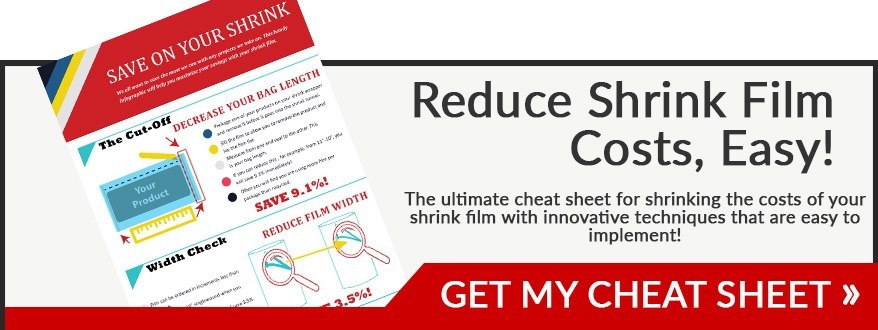Temperature Restrictions On Shrink Film
When it comes shrink film, temperature restrictions in extreme conditions is an important dynamic to consider. From the temperature that you run your products through the heat tunnel, to atmospheric conditions for your transportation vehicles, temperature matters. In the article below we will explore the role of temperature in relation to shrink film and how it reacts to packaging machinery.
What Is The Appropriate Range Of Temperatures For Shrink Film Storage?
When storing your shrink film prior to use, make sure that you have a general idea of the best practices for the extremes of both summer and winter storage. During these times of the year, temperature restrictions are of utmost importance for these materials. If shrink film gets too hot, it can melt and stick to itself. If shrink film gets too cold, it can become brittle and crack.
Overall, shrink film is best stored in temperatures between 30 and 77 degrees Fahrenheit. Naturally, summer and winter are the seasons which require you to be most attentive to your storage environment.
Here is an interesting case study done on the use of polyolefin shrink film which was used in several different temperatures for the packaging and preservation of pomegranates. From sciencedirect.com
"The effects of individual shrink film wrapping with two polyolefin films (BDF-2001 and D-955) and skin coating with a sucrose polyester (SPE) Semperfresh™ on the shelf life and quality of soft-seeded ‘Ganesh’ pomegranates (Punica granatum L.) stored at 8, 15 and 25°C were studied.
The shrink-wrapped pomegranates could be stored for 12, 9 and 4 weeks as compared to 8, 6 and 2 weeks by SPE coating at 8, 15 and 25°C respectively, whereas non-wrapped fruits could be kept for 7, 5 and 1 week under similar storage conditions.
You can read the rest of the study here.
Want To Learn How To Save Money With Shrink Film?
How Do You Properly Store Your Shrink Films?
Not Too Hot: During the hot summer months, you want to keep your film in the coolest spot in your warehouse, without being in a refrigerator. This tends to be nearest the floors, on the lowest portion of your pallet-racks. Keep the rolls out of direct sunlight and away from areas in your warehouse that are susceptible to the hot weather outside. Try to schedule your film deliveries early to beat out the sun, and avoid letting them sit in a hot trailer for extended periods of time.
Not Too Cold: If you place your film in a freezer, it may become damaged as well. In some instances where the film has been under extreme cold for too long, problems can occur. For example, PVC film can shatter like glass if dropped, presenting a whole different safety hazard. The goal is to keep the film rolls cool, but not freezing. When packaging frozen foods and other items that must be cooled in a refrigerator, it may be a good idea to use a quality polyolefin film instead.
Sometimes you can catch weather-damaged film before you place it on your shrink wrapper. Watch for:
Sticky Rolls: Not to be confused with those delicious cinnamon buns, sticky film is a warning sign that the shrink film has gotten too much heat. If you have 2 rolls near one another and they are stuck together, don't risk downtime on the packaging line. Find a cool roll to use.
Bagging and Sagging: Film that has seen too much heat before use may have begun to sag on the edges of the roll. Look for unusual issues like this, or bagging on the film before use. Using film that has issues like this can mess up the tracking on your machines, so be alert for damaged rolls, especially in the summer months.
What Temperature Should I Run My Shrink Film At In My Heat Tunnel?
The inside of your heat tunnel is an important dynamic to have locked in prior to packaging your product. The correct temperature for your product depends on which kind of substrate is being utilized. Furthermore, the appropriate heat for your product also depends on the gauge of your shrink film. More often than not, the most typical type of material run through a heat tunnel is 45 - 75 gauge PVC or polyolefin shrink film.
Lets run over a hypothetical situation that will allow you to better understand heat restrictions for your shrink films as they are passing through your heat tunnel. Say you are currently running a 75 gauge PVC shrink film;
An appropriate setting for PVC would be between 215 – 235 degrees Fahrenheit. Now, if you are going to use a polyolefin film with a gauge of 75, then an appropriate temperature for your heat tunnel would be about 255 – 275 degrees Fahrenheit. Keep in mind, these are just ballpark figures and depending on the dynamics of your equipment, materials and product, your actual settings may vary.
While these more traditional thicker gauges of film have been used for decades, new advances in technology have produced significantly thinner gauges of shrink film. Thinner gauges currently available include: 35 and 30 gauge. These new cutting edge lower gauge films have excellent strength, a lower carbon footprint and a lower cost. As these films are thinner than traditional shrink films, the temperature restrictions will be different and entirely based upon which gauge of film you choose to employ.
At the end of the day, your conveyor speed is ultimately more important than the temperature of your heat tunnel. Adjusting your shrink tunnel to a lower heat setting and a slower speed (2-3) will increase the life of the tunnel. That being said, all products and packaging lines are case sensitive and it would do you well to work with your packaging machinery and materials vendor to tweak the settings on your machinery and materials. This will ensure that you reach the best possible settings for your particular applications.
You may occasionally have what you consider to be a particularly sensitive product and are unsure if you should be using a heat tunnel to package your item. Requesting a test of the equipment using heat sensing tapes will allow you to gauge if your product should or should not be packaged with a heat tunnel in the first place. You can get a demonstration like this by reaching out to your packaging machinery and materials vendor and requesting said service.
Conclusion
Depending on the unique setup of your packaging line and the machinery and materials that you choose to run, temperature restrictions are an important element to keep a close eye on. When trying to figure out your best practices in regards to the storage of your materials, take into consideration the storage temperatures you should be using for your films. It is a good idea to work in tandem with your packaging machinery and materials vendor to find the correct temperatures for peak performance.
About Nathan Dube
As the Digital Marketing Specialist at Industrial Packaging, I am honored to create content for such a phenomenal company and work with one of the greatest teams in the Packaging Industry. Whether creating a video, writing blog posts or generating other pieces of content and multimedia, I am always excited to help educate and inspire our prospects and clients to reach their highest potential in regards to their packaging processes and needs.




